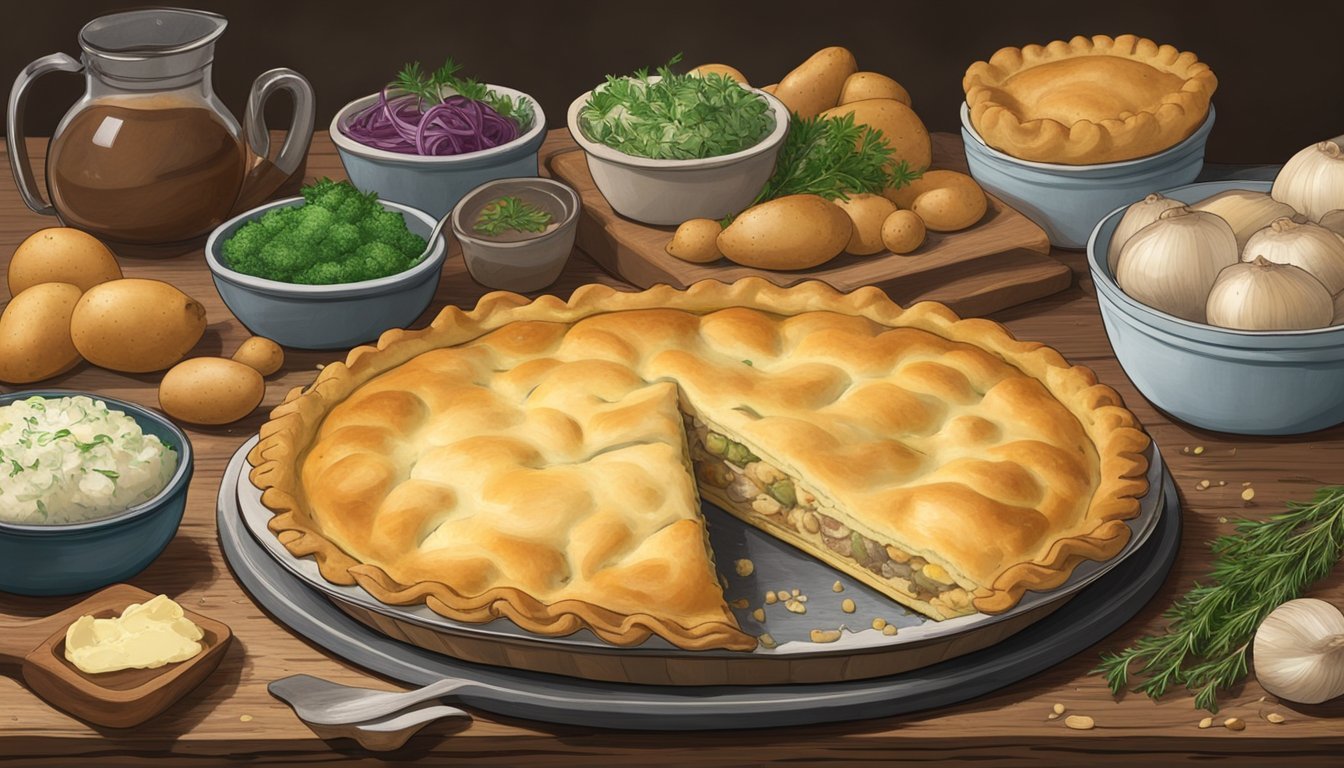Seal Flipper Pie
Exploring Atlantic Canada's Culinary Delight
Seal Flipper Pie is a culinary tradition steeped in the heritage of Newfoundland and Labrador, the easternmost province of Canada. Known for its unique and robust flavors, this dish offers a true taste of the Atlantic, capturing the essence of the region's sea-centric lifestyle. The pie features the unique ingredient of harp seal flippers, which are a byproduct of the annual seal hunt, a practice deeply rooted in the local culture and history.
This distinctive pie has been a part of Newfoundland and Labrador's cuisine since as early as 1555. Historically enjoyed during the Lenten season, notably on Good Friday and Easter, it's a dish that has sustained generations. The preparation of seal flipper pie involves a slow braise of the meat, which is then stewed with a thick gravy, carrots, onions, (What wine goes well with onions?) and sometimes peas, embodying the heartiness expected of a seafaring community's diet.
The savory filling is encased in a pastry shell and baked until golden, the cooking process often involves adding local ingredients like onions and salt pork, and sometimes a splash of the province's own Newfoundland Screech, a type of rum. This dish not only survives but thrives as a testament to Newfoundland and Labrador's rich history and connection to the Atlantic, a region where the ocean's bounty is celebrated and respected in equal measure.
Historical Significance
Seal Flipper Pie has deep roots in Newfoundland and Labrador's history, closely intertwined with seasonal traditions and local economy.
Origins of the Dish
The Seal Flipper Pie stems from a time-honored tradition that dates back to the 16th century when French and Basque fishermen first brought the dish to the East Coast of Canada. Originating in Newfoundland and Labrador, this unique pie is made with harp seal flippers, which became a popular ingredient due to the annual seal hunt, regarded as a crucial event for the community.
Cultural Importance
Seal Flipper Pie is more than a dish—it's an embodiment of cultural resilience and adaptation. Consumed during Lent and Easter, it signifies the community's resourcefulness during times when other meat sources were not available. The recipe has been preserved and passed down through generations, often accompanied by a dram of Newfoundland Screech as part of its traditional serving. It has remained a symbol of Newfoundland's heritage, especially in the context of the Lenten season and the annual seal hunt, which are pivotal to the historical and cultural narratives of Canada's East Coast.
Ingredients and Preparation
Seal Flipper Pie combines traditional ingredients and methodical preparation to create a dish that's a staple in Newfoundland cuisine. This section explores the core components and steps involved in making the pie.
Key Ingredients
Seal Flippers: The principal ingredient of the recipe offering a unique taste from the Atlantic.
Vegetables: A mix of diced root vegetables to add flavor and texture. Commonly used are:
Onion
Carrots
Potato
Turnip
Fat Pork: Sliced fat pork layers for richness.
Seasonings: Salt and Pepper are the fundamental seasonings used for taste.
Flour: For thickening the gravy and making the pastry.
Liquids:
Water: for the stew and pastry.
Vinegar: a splash to tenderize the meat and add to the pastry.
Pastry Ingredients:
Flour
Baking Powder
Butter or Margarine
Water
Pastry Preparation
Combine 1 cup flour with 1-1/2 tsp. baking powder.
Cut in 1 tbsp. butter or margarine until the mixture resembles coarse crumbs.
Stir in enough water and a hint of vinegar to form a dough.
Roll the dough out to fit the pie dish for both bottom lining and top covering.
Cooking Method
Preheat the oven to 375 degrees F (190 degrees C).
Layer the bottom of a baking dish with seal flippers, sliced onions, and fat pork.
Pour a drizzle of the regional Newfoundland Screech over the ingredients.
Cover and bake the dish in the oven for about 2 hours until the meat is tender.
Meanwhile, cook diced root vegetables in boiling water for 20 minutes.
Once the flipper meat is tender, arrange the boiled vegetables in the dish and cover with the pastry dough.
Return to the oven to bake until the pastry is golden brown, which should take another 15-30 minutes.
Use the vegetable water left over to create a savory gravy by thickening it with flour.
Nutritional Information
In assessing the nutritional profile of Seal Flipper Pie, one must consider the primary ingredient, seal meat, which provides a rich source of protein and other nutrients. Seal meat is lean and substantial in iron and vitamin A, making it a substantial food choice.
Health Benefits
Protein: Seal meat is an excellent source of high-quality protein, essential for muscle repair and growth.
Iron: A serving of seal meat contains a significant amount of iron, crucial for oxygen transport and energy production in the human body.
Vitamin A: Vitamin A found in seal meat supports immune health, eye health, and skin integrity.
Omega-3 Fatty Acids: Seal oil is high in omega-3 fatty acids, such as EPA, which are known to support cardiovascular health and may have anti-inflammatory properties.
Considerations on Consumption
Sustainable Practices: Newfoundland and Labrador have a history of relying on seal hunting, often emphasizing sustainable practices. When consuming seal products, it's important to consider the source and the methods used to ensure they align with sustainable standards.
Cultural Significance: Seal Flipper Pie has deep cultural roots in Newfoundland and Labrador and reflects the traditional diet of the region.
Dietary Restrictions: Individuals with dietary restrictions should be aware that seal meat is a type of game meat and may not be suitable for all diets.
Availability: Seal products may not be widely available and are subject to legal considerations in certain regions, impacting consumption choices.
Contemporary Relevance
Seal flipper pie, a traditional Maritime dish, remains a topic of culinary and ethical discussion in contemporary society, where it straddles the line between cultural heritage and modern sensibilities.
Modern Adaptations
Chefs in Newfoundland have been incorporating seal flipper pie into their menus with innovative twists, ensuring its survival in modern cuisine. One such example is Mallard Cottage in Quidi Vidi Village, where the dish is prepared with a respect for tradition yet plated in a style appealing to contemporary palates. The protein-rich seal meat is still at the heart of the recipe, but its preparation may now include locally-sourced ingredients and creative cooking methods. This has made the dish more accessible to those who might be reluctant to try this piece of Canadian gastronomy.
Controversies and Ethics
While seal flipper pie forms a part of Canada's cultural tapestry, it is not without controversy. Seal hunting has been criticized by various animal rights activist groups who raise concerns about the sustainability of seal populations and the welfare of the animals. The Canadian Department of Fisheries and Oceans regulates this practice to ensure that it does not threaten endangered species, and maintains that it is a critical economic driver for many communities.
Conversely, many defend the harvesting of seal products as a continuation of indigenous practices and an essential aspect of Newfoundland's economy. As with many other game meats, the debate around seal flipper pie navigates the complex waters of cultural tradition, sustainable practice, and animal ethics.
Regional Variations
While Seal Flipper Pie is strongly associated with Newfoundland and Labrador, variations can be seen across different regions in Canada, each with their own unique take on this traditional dish.
Newfoundland Variations
In Newfoundland, Seal Flipper Pie is regarded as a cultural staple that connects the community to its maritime roots and the practice of sustainable use of local resources, namely seal flippers. The classic Newfoundland Seal Pie recipe typically includes flippers that are first coated in flour, pan-fried to a golden brown, and then slow-roasted with a medley of root vegetables like turnip and parsnip. The use of Worcestershire sauce adds depth to the rich gravy that characterizes many local iterations of this dish.
Other Canadian Influences
Moving to other Canadian regions, such as Quebec, permutations of the dish begin to surface, often reflecting that area's culinary preferences. In some cases, other proteins, such as cod, a fish with deep ties to Atlantic Canadian history, may be incorporated into the pie. Quebec's rendition might also see the introduction of local herbs and seasonings, creating a variation that speaks to the province's Francophone heritage. While not traditionally used for Seal Flipper Pie, pelts from the seal hunt are a testament to the utilization of the animal in other cultural practices and products in Canada.
The regional variations of Seal Flipper Pie showcase Canada's diverse culinary landscape and the adaptability of traditional recipes to local flavors and ingredients.
Serving and Pairing
Seal Flipper Pie is more than just a dish; it represents a slice of Newfoundland heritage, deeply rooted in tradition. Often served during Lent, especially on Good Friday and Easter, it also coincides with the annual seal hunt. The prime way to serve Seal Flipper Pie is freshly baked, its pastry golden-brown and flaky, often alongside seasonal root vegetables such as carrots, turnips, potatoes, (What wine goes well with potatoes?) and parsnips.
The robust flavor of the seal flippers can be enhanced through careful pairing. A traditional approach to serving the pie employs the concept of balancing flavors.
Suggested Pairings:
Vegetables: Root vegetables, as part of the pie itself or served on the side, help to absorb the richness of the meat.
Beverages: The strong taste of the meat is well complemented by a glass of Newfoundland Screech. This dark rum, a cultural icon of the region, contrasts with the savoriness, adding a hint of sweetness to the palate.
When considering garnishes and additional sides, simplicity is key. The dish is hearty, and a light, fresh salad could serve to refresh the palate between bites. A tangy vinaigrette dressing on the salad can offer a sharp contrast to the lush flavors of the pie.
To respect the cultural essence of Seal Flipper Pie, it's crucial to partake in the meal with a nod to its origins, understanding the significance of this traditional Newfoundland fare and the stories that have been passed down with each serving.
Conclusion
Seal Flipper Pie is not merely a dish; it represents a significant part of Newfoundland's culinary heritage. This traditional delicacy brings forth a unique taste that encapsulates the rugged spirit and the historical sustenance practices of the Atlantic region. With its rich gravy and tender seal meat, enveloped in a flaky pastry, the dish offers a hearty and distinctive culinary experience.
Availability: Primarily found in Newfoundland and Labrador, its consumption is particularly notable during special occasions such as Easter and the Lenten season. It showcases the interconnection between local communities and their natural resources, particularly the seal population.
Culinary Tradition:
Roots in History: Dating back to 1555.
Ties to the Community: Often associated with the annual seal hunt.
Cooking Techniques: Involves slow-cooking of the seal flippers.
Modern Interpretations: While staying true to its origins, chefs in contemporary kitchens are now putting their twist on this regional staple, possibly infusing new life while respecting its rich lineage.
In exploring Atlantic Canadian cuisine, one recognizes the importance of dishes like Seal Flipper Pie in the cultural fabric of the region. It stands as a testament to the resourcefulness and resilience of the communities that have relied on the bounties of the Atlantic for centuries.








